MP Board Class 9th Science Solutions Chapter 6 Tissues
Tissues Intext Questions
Tissues Intext Questions Page No. 69
Question 1.
What is a tissue?
Answer:
A group of cells that are similar in structure and / or work together to achieve a particular function form a tissue.
Question 2.
What is the utility of tissues in multi – cellular organisms?
Answer:
In multi – cellular organisms, different types of tissues perform different functions. Since a particular group of cells carry out only a particular function, they do it very efficiently. So, multi – cellular organisms possess a specific division of labour.
Tissues Intext Questions Page No. 74
Question 1.
Name types of simple tissues.
Answer:
- Parenchyma
- Collenchyma and
- Sclerenchyma
Question 2.
Where is apical meristem found?
Answer:
At root tip and shoot tip.
Question 3.
Which tissue makes up the husk of coconut?
Answer:
Sclerenchymatous tissue.
Question 4.
What are the constituents of phloem?
Answer:
Phloem is made up of four types of elements: Sieve tubes, companion cells, phloem fibres and the phloem parenchyma.
Tissues Intext Questions Page No. 78
Question 1.
Name the tissue responsible for movement in our body.
Answer:
Muscular, tissue.
Question 2.
What does a neuron look like?
Answer:
A neuron is the unit of nervous tissue. It is elongated in shape and consists of three parts viz., dendrites, cell body and axon.
![]()
Question 3.
Give three features of cardiac muscles.
Answer:
- Cardiac muscle cells are cylindrical, branched and uninucleate.
- They show rhythmic contraction and relaxation throughout life.
- They are involuntary muscles.
Question 4.
What are the functions of areolar tissue?
Answer:
Areolar tissue fills space inside the organs, supports internal organs and helps in repair of the tissues.
Tissues NCERT Textbook Exercises
Question 1.
Define the term ‘tissue’.
Answer:
The group of cells similar in structure that work together to achieve a particular function forms a tissue. This group of cells has a common origin.
Question 2.
How many types of elements together make up the xylem tissue? Name them.
Answer:
Xylem is formed of four types of elements.
They are:
- tracheids
- vessels
- xylem parenchyma
- xylem fibre.
Question 3.
How are simple tissues different from complex tissues in plants?
Answer:
Simple tissues are made of one type of cells which coordinate to perform a common function.
Complex tissues are made of more than one type of cells. All these coordinate to perform a common function.
Question 4.
Differentiate between parenchyma, collenchyma and sclerenchyma on the basis of their cell wall.
Answer:

Question 5.
What are the functions of the stomata?
Answer:
Functions of stomata:
- Exchange of gases, particularly CO2 and O2 with atmosphere.
- Loss of water in the form of vapours during transpiration.
Question 6.
Diagrammatically show the difference between the three types of muscle fibres.
Answer:
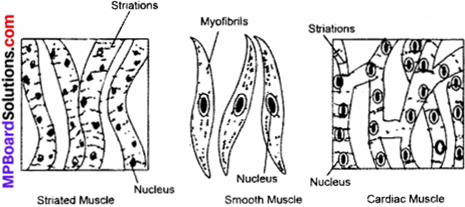
Question 7.
What is the specific function of the cardiac muscle?
Answer:
The specific function of cardiac muscle is to contract and relax rhythmically throughout life.
Question 8.
Differentiate between striated, unstriated and cardiac muscles on the basis of their structure and site / location in the body.
Answer:

Question 9.
Draw a labelled diagram of a neuron.
Answer:
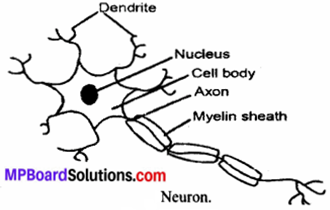
Question 10.
Name the following:
- Tissue that forms the inner lining of our mouth.
- Tissue that connects muscle to bone in humans.
- Tissue that transports food in plants.
- Tissue that stores fat in our body.
- Connective tissue with a fluid matrix.
- Tissue present in the brain.
Answer:
- Squamous epithelium.
- Tendons.
- Phloem.
- Adipose tissue.
- Blood.
- Nervous tissue.
Question 11.
Identify the type of tissue in the following: skin, bark of tree, bone, lining of kidney tubule, vascular bundle.
Answer:
- Skin: Striated squamous epithelium
- Bark of tree: Cork (protective tissue)
- Bone: Connective tissue
- Lining of kidney tubule: Cuboidal epithelium tissue
- Vascular bundle: Conducting tissue (xylem and phloem).
Question 12.
Name the regions in which parenchyma tissue is present.
Answer:
Parenchyma is found in cortex and pith of both root and stem. When it contains chlorophyll, it is called chlorenchyma, found in green leaves.
![]()
Question 13.
What is the role of epidermis in plants?
Answer:
Cells of epidermis form a continuous layer without intercellular spaces. It protects all the parts of the plant.
Question 14.
How does the cork act as a protective tissue?
Answer:
In older plants, the secondary meristem forms on its outerside several layered thick cork or the bark. Cork acts as a protective tissue because:
- Its cells are dead and compactly arranged without intercellular spaces
- Its cells also have deposition of suberin in their walls that makes them impervious to gases and water.
Thus, cork protects the underlying tissues from excessive loss of water, adverse external environment and mechanical injuries.
Question 15.
Complete the table:

Answer:

Tissues Additional Questions
Tissues Multiple Choice Questions
Question 1.
The spindle shaped cells, uninucleated and unbranched are present in muscular tissue of _________.
(a) Striated muscles
(b) Smooth muscles
(c) Cardiac muscles
(d) Both (a) and (b).
Answer:
(b) Smooth muscles
Question 2.
The size of the stem increases in the width due to _________.
(a) Apical meristem
(b) Intercalary meristem
(c) Primary meristem
(d) Lateral meristem.
Answer:
(d) Lateral meristem.
Question 3.
The cells of cork are dead and have a chemical in their walls that makes them impervious to gas and water. The chemical is _________.
(a) Lignin
(b) Suberin
(c) Cutin
(d) Wax.
Answer:
(b) Suberin
Question 4.
The tissue that helps in the movement of our body are _________.
(a) Muscular tissue
(b) Skeletal tissue
(c) Nervous tissue
(d) All of the above.
Answer:
(d) All of the above.
Question 5.
The connective tissue that connects muscle to bone is called _________.
(a) Ligament
(b) Tendon
(c) Cartilage
(d) Areolar.
Answer:
(b) Tendon
Question 6.
Cartilage and bone are types of _________.
(a) Muscular tissue
(b) Connective tissue
(c) Meristematic tissue
(d) Epithelial tissue.
Answer:
(b) Connective tissue
Question 7.
A tissue whose cells are capable of dividing and re – dividingis called _________.
(a) Complex tissue
(b) Connective tissue
(c) Permanent tissue
(d) Meristematic tissue.
Answer:
(d) Meristematic tissue.
Question 8.
The tissue that helps in the secretion and absorption and is found in the inner lining of the alimentary canal is?
(a) Ciliated epithelium
(b) Cuboidal epithelium
(c) Squamous epithelium
(d) Columnar epithelium.
Answer:
(d) Columnar epithelium.
![]()
Question 9.
The flexibility in plants is due to a tissue called?
(a) Chlorenchyma
(b) Parenchyma
(c) Sclerenchyma
(d) Collenchyma.
Answer:
(d) Collenchyma.
Question 10.
The tissue present in the lining of kidney tubules and ducts of salivary glands is?
(a) Squamous epithelium tissue
(b) Glandular epithelium tissue
(c) Cuboidal epithelium tissue
(d) Columnar epithelium tissue.
Answer:
(d) Columnar epithelium tissue.
Tissues Very Short Answer Type Questions
Question 1.
Name two main groups of plant tissue.
Answer:
Two groups are:
- meristematic tissues and
- permanent tissues.
Question 2.
Where will you look for meristematic cells in a plant body?
Answer:
The meristematic cells are present only at the growing regions such as shoot tips, root tips and at the base of the leaves or internodes.
Question 3.
What are simple permanent tissues?
Answer:
Simple permanent tissues consist of one type of cells which look like each other.
Question 4.
Name two types of simple permanent plant tissues.
Answer:
Simple permanent plant tissues are:
- Parenchyma
- Collenchyma and
- Sclerenchyma.
Question 5.
Write four elements of xylem.
Answer:
- Tracheids
- Vessels
- Xylem parenchyma
- Xylem fibres.
Question 6.
What are the three types of muscle fibres (muscle cells)?
Answer:
Three types of muscle fibres are:
- Striated muscle (skeletal muscle or voluntary muscle).
- Unstriated muscle (smooth muscle or involuntary muscle).
- Cardiac muscle.
Question 7.
What are the various functions of all types of epithelial tissues?
Answer:
Epithelial tissues help in
- protection
- absorption
- excretion
- exchange of respiratory gases
- secretion.
Question 8.
What is basement membrane?
Answer:
It is a very thin non – cellular membrane on which cells of epithelial tissue rest. It also separates the epithelial tissue from the underlying tissues.
![]()
Question 9.
Of which type of muscles the stomach wall is made of? Whether they are voluntary or involuntary?
Answer:
Smooth or non-striated. They are involuntary muscles.
Question 10.
What is the function of connective tissue?
Answer:
Connective tissue connects different tissues and organs. It provides support to different parts of the body by forming packing around different organs of the body
Question 11.
What are the two main features of connective tissue?
Answer:
- Cells are loosely spaced and are embedded in matrix.
- Matrix may be jelly – like, fluid, dense or rigid.
Question 12.
Name one animal whose whole skeleton is made of cartilage.
Answer:
Shark fish.
Question 13.
List seven examples of connective tissue.
Answer:
- Bone
- Cartilage
- Tendons
- Ligaments
- Areolar tissue
- Adipose tissue and
- Blood.
Question 14.
What are blood platelets?
Answer:
Blood platelets are minute (about 2 to 4μ in diameter), anucleated, disc like bodies. The main function of platelets is to help in clotting of blood.
Question 15.
Name the connective tissue that is found between skin and muscles.
Answer:
Areolar connective tissue fills the space between skin and muscles.
Question 16.
How would you recognize that the slide given to you is of striated muscle? Give only two important points.
Answer:
- Striated muscles have light and dark bands (which gives it a striped look).
- Striated muscle fibres are not branched like cardiac muscles.
Question 17.
From which part of a nerve cell, dendrites arise?
Answer:
The cell body.
![]()
Question 18.
Name the tissue present in the brain.
Answer:
Nervous tissue (formed of neuron cells).
Question 19.
Which cell is the longest in the body of an animal?
Answer:
Neuron (Nerve cell) which may be upto 1m long (in special cases).
Question 20.
Name a fluid, except blood, which circulates in the body.
Answer:
Lymph.
Question 21.
Why are striated muscles generally called skeletal muscles?
Answer:
In general, striated muscles are attached with the bones. They help in the movement of the bones. So, they are also called skeletal muscles.
![]()
Question 22.
Name one muscle which does not fatigue and works throughout life in normal conditions.
Answer:
Cardiac muscles.
Question 23.
How are ligaments different from tendons?
Answer:
Ligaments are elastic connective tissues which attach bones with each other to keep them in then placer Tendons arc less elastic connective tissues which attach, muscles to a bone.
Question 24.
What is the main function of meristematic tissue?
Answer:
The mam function of meristematic tissue is to form continuously new cells for increasing cell number, length and the girth of the plant.
Tissues Short Answer Type Questions
Question 1.
How do tissues formed in multicellular organisms?
Answer:
During development from zygote (formed by the union of egg and sperm), a large number of cells are formed. These cells undergo differentiation to produce various specialised tissues to perform different functions in the living body.
Question 2.
What are the characteristics of plant tissues?
Answer:
Plants are stationary or fixed, they do not need much energy. So, most of the tissues they have are supportive, which provide them with structural strength. Most of these tissues are dead; they do not contain living protoplasm.
![]()
Question 3.
What are structural and functional differences between plants and animals?
Answer:
As plants do not move, they do not need much energy. So, most of the tissues they have are dead and supportive. But animals need energy as they move around in search of food, mate and shelter. So, most of the animal tissues are living.
Question 4.
Why do meristematic cells lack vacuoles?
Answer:
Meristematic cells divide frequently to give rise to new cells. So, they need dense cytoplasm and soft cell wall. Vacuoles cause hindrance in cell division as they are full of cell sap and provide turgidity and rigidity to the cell.
Question 5.
What are characteristic structural features of meristematic cells ?
Answer:
Meristematic cells have:
- Thin cell walls.
- Abundant or dense cytoplasm and single large nucleus.
- Spherical, oval, polygonal or rectangular shape.
- No intercellular spaces between them.
- Either no vacuoles at all or a few vacuoles.
Question 6.
List any four salient features of meristematic tissue.
Answer:
- This tissue consists of actively dividing cells.
- This tissue is present in growing regions of plants.
- In this tissue, cells are packed closely without intercellular spaces.
- Cells of this tissue have thin cell walls, dense cytoplasm and prominent nuclei.
Question 7.
What are permanent tissues?
Answer:
The cells of meristematic tissue lose the ability to divide and get differentiated into specialised cells. These differentiated cells form different types of tissues which are known as permanent tissues.
Some examples: permanent tissues are
- parenchyma
- sclerenchyma etc.
Question 8.
With the help of only schematic line diagram, show classification of main permanent tissues.
Answer:
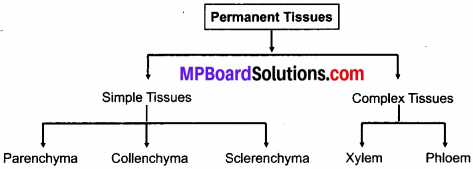
Question 9.
Write the characteristics of collenchyma.
Answer:
The cells in this type of tissue are living, elongated and thickened with cellulose at the corners. There is very little intercellular space. This tissue provides flexibility and mechanical support to plants. It is found in hypodermis of stems and leaf stalks.
Question 10.
What are protective tissues?
Answer:
All parts of plants e.g., leaves, flowers, stems and roots are covered by a single outermost protective layer called epidermis. It consists of rectangular, closely fitted relatively flat cells which lack intercellular spaces. Usually, it is one cell thick and is covered with cutin. Epidermis protects internal tissues of the plant.
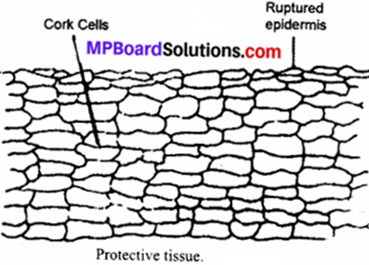
Question 11.
Does the outer most protective layer is throughout, continuous? If not, what interruptions are usually foundation leaves and herbaceous parts of the plant?
Answer:
Epidermis is the outermost layer of cells in leaves and green herbaceous stems. It is not a continuous layer as it contain numerous minute pores called stomata.
Question 12.
Write major functions of stomata present in the epidermis.
Answer:
Major functions of stomata:
- Stomata are essential for exchange of gases – oxygen and carbon dioxide between the plant and the atmosphere.
- Normally, plants remove excessive water in the form of vapour through stomata. This process is called transpiration.
Question 13.
What is the main function of vascular tissues in plants?
Answer:
Vascular tissues transport:
- Water and dissolved minerals from toots to various parts of the plant (xylem).
- Prepared food material from leaves to different plant parts (phloem).
Question 14.
What ire vascular bundles?
Answer:
In plants, complex tissues xylem and phloem altogether constitute a structure called vascular bundle. Their main function is transportation of water, salts and food materials within the plant body.
Question 15.
List four elements of phloem. Which one of them is most important and why?
Answer:
Phloem consists of following four elements:
- Sieve tubes
- Companion cells
- Phloem parenchyma
- Phloem fibres.
The most important element of phloem is sieve tubes because they translocate food materials from leaves to other parts of plant.
![]()
Question 16.
What is muscular tissue? What is their function?
Answer:
1. Muscular tissue: This is a specialised tissue which is composed of contractile, fibre – like cells. This tissue is responsible for movement in our body.
2. Function: The movement of the body or limbs is brought about by contraction and relaxation of contractile proteins present in the muscle cells.
Question 17.
In desert plants, epidermis is covered by waxy substances. Can you think why?
Answer:
Waxy substances which cover epidermis are waterproof and hence, they check loss of water during transpiration. Besides this, they also aid in protection against mechanical injury and invasion by parasitic fungi.
Question 18.
What are the four important types of tissues found in animals?
Answer:
The four animal tissues found in animals are:
- Epithelial tissues.
- Connective tissues.
- Muscular tissues and.
- Nervous tissue.
Question 19.
State one important function of each of the following:
- Areolar tissue
- Cuboidal epithelium.
Answer:
- Areolar tissue: It fills the space inside the organs, supports internal organs and helps in repair of tissues.
- Cuboidai epithelium: it forms the lining of kidney tubules and ducts of salivary glands where it provides mechanical support.
Question 20.
What are the two main components of blood? Why is blood considered a type of connective tissue?
Answer:
Blood has two main components:
- Fluid (liquid) matrix called plasma.
- Suspended red blood cells (RBCs), white blood cells (WBCs) and platelets.
Blood is considered as a connective tissue because:
- It has the same Origin as the other connective tissues.
- It flows to different parts of the body and thus, connects different parts of the body with one another to exchange materials and gases.
Question 21.
Why do blood and lymph called as connective tissues?
Answer:
The fluid tissue (blood and lymph) connects various parts (cells) of the body. It supplies nutritive materials, oxygen and hormones collected from different organs to the body tissues. It also collects waste materials from different body tissues and delivers to excretory organs.
![]()
Question 22.
Why is blood called as fluid connective tissue?
Answer:
Blood is considered as a connective tissue because it connects different parts of the body. It contains plasma as matrix in which blood cells remain suspended. Being matrix (plasma) in liquid state, blood is called fluid connective tissue.
Question 23.
Explain how the bark of a tree is formed. How does it act as a protective tissue?
Answer:
As trees grow old, a strip of secondary meristem replaces the epidermis of the stem. Cells on the outside are cut off from this layer. This forms the several layer thick cork or the bark of the tree. Bark is a mass of dead tissue lying in the peripheral region of the plant body as a hard dry covering. Its function is protection. It protects the inner tissues against the attack of fungi and insects, against loss of water by evaporation etc.
Question 24.
What is the difference between voluntary and involuntary muscles? Give example of each.
Answer:
Voluntary muscles are those which are directly under control of our will
e.g.
- skeletal muscle.
They work or contract on our command. Involuntary muscles are not under the command of our will. We cannot control contraction and relaxation of these muscles. They are of two types – smooth muscles and cardiac muscles. Smooth muscles are found in stomach, intestine, iris of eye, in ureters and in the bronchi of lungs. Another type of involuntary muscles that is, cardiac muscles are found in heart.
Tissues Long Answer type Questions
Question 1.
The following diagrams are of L.S. of shoot apex and L.S. of root apex. Observe the diagrams and answer the questions given below:
- What type of cells shoot apex and root apex consists of?
- What are the main characteristics of these cells?
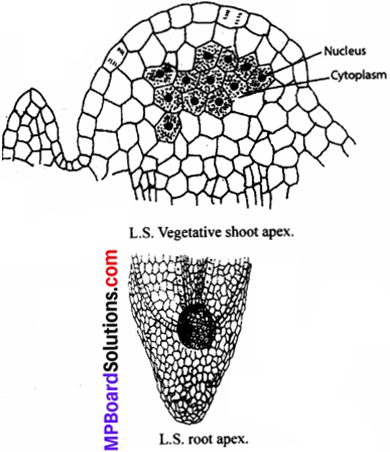
Answer:
- Meristematic cells.
- (a) Cells have big nucleus and dense cytoplasm.
- (b) These cells lack intercellular spaces and vacuoles.
Question 2.
How many types of meristems are present in plants, on the basis of position?
Answer:
On the basis of location of meristem, it is classified into three types:
1. Apical meristem: It is present at the tip of stem, root and their branches.
2. Intercalary meristem: It is found at the leaf base, above the nodes (i.e. at the base of internodes as in grasses) or below the nodes (i.e. at the upper most region of internode as in mint.)
3. Lateral meristem: Vascular cambium and cork cambium are the examples of lateral meristem. Vascular cambium is found in vascular bundles while cork cambium is found underneath the bark of trees. Both of these cause increase in the girth of plants.
Question 3.
Draw a labelled diagratn of shoot to show location of meristematic tissues in the plant body and write the functions of each of them.
Answer:
Functions:
- Apical meristem: It increases the length of the stem and the root.
- Lateral meristem (cambium): It increases the girth of the stems and roots.
- Intercalary meristem: It is present at the base of the leaves or internode (on either side of the node).
It produces buds which develop in auxiliary branches or auxiliary floral branches.
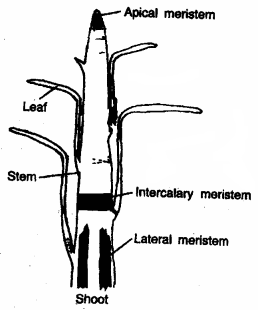
Question 4.
Explain the structure of parenchyma. What are its major modifications?
Answer:
Parenchyma: It is the basic or fundamental tissue found in plants. Cells of this tissue are thin walled, circular or polygonal. They are living with a nucleus and a vacuole. Intercellular spaces are present between the cells of this tissue. Two modifications of parenchyma are chlorenchyma and aerenchyma.
Chlorenchyma: Sometimes cells of the parenchyma contain chlorophyll and perform photosynthesis. This kind of parenchyma is known as chlorenchyma.
Aerenchyma: In aquatic plants, parenchyma contains big air spaces in between them. Such a parenchyma tissue is known
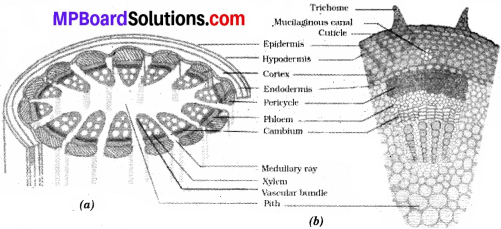
(a) Parenchyma with intercellular spaces.
(b) Aerenchyma with big spaces
Question 5.
Write the main functions of parenchyma.
Answer:
Functions of the parenchyma:
- They store food.
- They provide temporary support by retaining the turgid condition of cells.
- Chlorenchyma containing chloroplasts prepare food through photosynthesis.
- In aquatic plants, aerenchyma gives buoyancy to plants and hence they can float easily.
Question 6.
Describe the structure of selerenchyma. Write its major functions.
Answer:
Selerenchyma: Selerenchyma is the chief mechanical tissue of plants. The cells of this tissue are usually long, narrow and pointed at both ends. Due to deposition of lignin, their walls are often very highly thickened. Hence, the lumen of cell cavity is nearly obliterated. They are usually provided with simple pits which may be oblique or straight.
The selerenchyma cells are dead cells and their main function is to provide strength and rigidity to the plant.
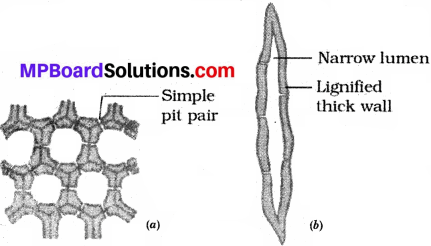
Question 7.
What is xylem? Explain its structure. Which one of its component is very important and why?
Answer:
Xylem is a complex plant tissue which transports water and dissolved minerals from roots to all other plant parts.
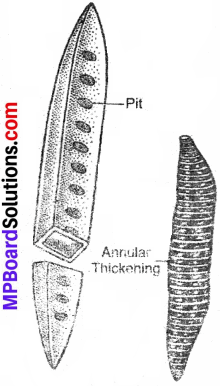
Structure: Xylem consists of four kinds of cells (also known as elements):
(i) Tracheids: A tracheid is an elongated, hollow cell with its both ends tapering. The walls of these cells are thickened by the deposition of lignin. At certain spots lignin is not present. These spots are termed as pits. The tracheids are dead cells.
(ii) Vessels: These are tube like structures formed by a number of cells placed end to end with their transverse walls dissolved. The side walls of these tubes also have deposition of lignin. The thickening of the walls show various kinds of patterns. They are also dead cells.
(iii) Xylem parenchyma: These are parenchymatous, thin walled, living cells. They help in lateral conduction of water and sap. They also store food.
(iv) Xylem fibres: They are lignified dead fibres which provide mechanical support to plant. The most important element of xylem is vessel because most of the water and minerals are carried upward through this component of xylem.
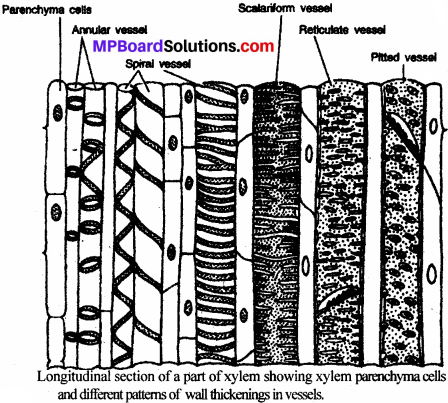
Question 8.
Describe the structure of phloem.
Answer:
Structure of phloem: The main conducting part of the phloem is sieve tube which is formed of elongated cylindrical cells arranged in vertical rows. The walls between the cells have many minute pores through which food material can pass from one cell to the next. The porous walls between the cells is termed as sieve plate. Each sieve tube is supported by a long parenchymatous cell called the companion cell which helps the sieve tubes in the conduction of food material.
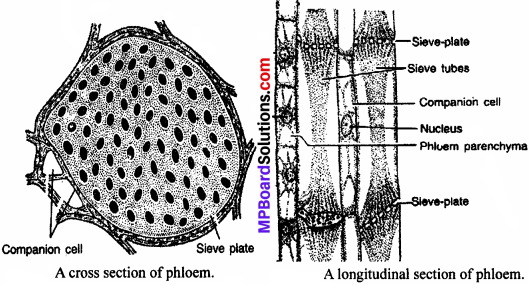
The above figure shows that phloem also contains phloem fibres, which provide mechanical support. Another component of phloem is parenchyma cells which stores food.
Question 9.
What is epithelial tissue?
Answer:
Epithelial Tissue: Epithelial tissue forms covering of entire surface of the body and lines the internal organs. Because of this, epithelial tissue is also called protective tissue. It also forms a barrier to keep different body systems separate. In this tissue cells are closely associated and arranged on a very thin extracellular fibrous basement membrane. Epithelial tissue may be composed of one (simple epithelium) or more layers of cells (compound epithelium). The skin, lining of mouth and alimentary canal, lung alveoli etc. are made of epithelial tissues.
Question 10.
What are the four main functions of epithelial tissue?
Answer:
The four main functions of epithelial tissue are:
- It forms the outer layer of skin and hence it protects the underlying cells from drying, injury, bacterial and chemical effects..
- It forms lining of mouth, alimentary canal and other internal organs and thus protects these organs.
- It helps in absorption of water and other nutrients in alimentary canal.
- Some of them are greatly specialised and perform secretory function.
Question 11.
What are the categories of epithelial tissue depending upon the shape and function of epithelial cells?
Answer:
Depending upon the shape and function of the cells, epithelial tissue is classified as:

Question 12.
What are the various forms of epithelial tissues? Describe briefly.
Answer:
(i) Squamous epithelium: The cells of this tissue are thin and flat forming a delicate lining. It is found in the alveoli and blood vessels. Tongue, oesophagus and lining of mouth also made up of squamous epithelium.
(ii) Cuboidal epithelium: The cells of this tissue are cube like in appearance. It is found in the lining of kidney tubules and ducts of salivary glands etc.
(iii) Columnar epithelium: The cells of this tissue are more tall and wide, placed side by side. Their nuclei are situated near the bases. They may have finger like . projections – the microvilli on their free surfaces. This tissue usually lives in the internal surface of stomach and intestine.
(iv) Ciliated epithelium: The cells of this tissue are modifications of columnar epithelial cells. They have many small hair like projections called cilia on their free ends. This type of epithelium is found in trachea and oviduct.
(v) Striated squamous epithelium: Cells of this tissue are similar to squamous epithelial cells but in this tissue they are arranged in many layers to prevent wear and tear of parts. In skin, striated squamous epithelium is found.
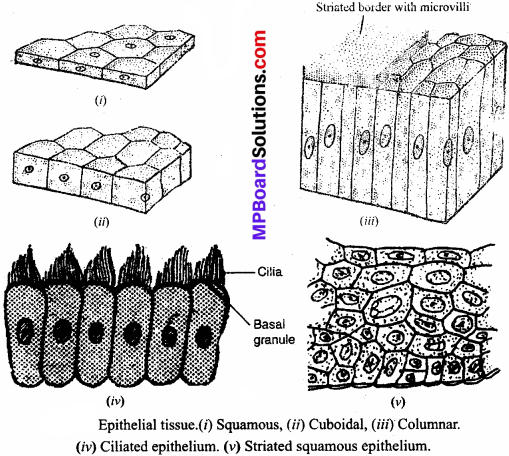
(vi) Glandular epithelium: In this type of epithelium, cells secrete substances at the epithelial surface. Such type of epithelium is found in glands.
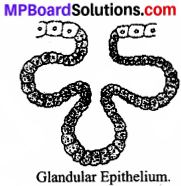
Question 13.
Explain the structure of three types of muscle fibres. Also write the locations where they are found in the body.
Answer:
The following are the three types of muscle cells:
(i) Unstriated muscles: (Also known as smooth, involuntary muscles). This type of muscular tissue consists of spindle – shaped, long uninucleate cells. These muscles are present in alimentary canal, blood vessels, iris of eye, in ureters and bronchi of lungs etc.
(ii) Striated muscles: Also known as voluntary muscles because of their function being in our control or will. This type of muscular cells are long multi – nucleated and, enclosed in a membrane known as sarcolemma. Each fibre has several longitudinal filaments embedded in cytoplasm. These filaments give these muscles striated appearance. These muscles are attached to the skeleton; so they are also called skeletal muscles.
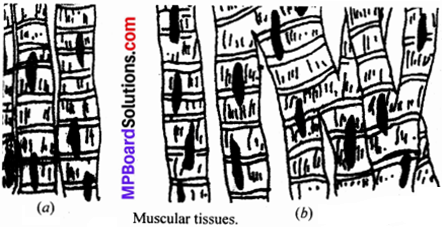
(iii) Cardiac muscles: These muscles are found in heart. They are not under the control of the will. They contract rhythmically and involuntarily throughout life without the sign of fatigue. Structurally they show the characters of both unstriated and striated muscles. They are made up of branched fibres. These fibres are uninucleated and show alternate light and dark bands (striations).
Question 14.
What are three main categories of connective tissue?
Answer:
Categories of Connective Tissue:
(i) Connective tissue: There is a matrix in which generally two types of (white and yellow) fibres are present. In between these fibres some connective tissue cells are present.
Examples of this kind of connective tissues are
- areolar tissue and
- adipose tissue.
(ii) Skeletal tissue: This type of tissue forms the skeleton of an organism. It is of two types – cartilage and bone Cartilage has solid matrix, called chondrin, in which fibres and cells known as chondrocytes are present. Usually, cells are present in clusters of 2 – 3 cells in small spaces called lacunae. Cartilage is found in the regions of pinna, nose, trachea and larynx. In bones, matrix is formed of a protein called ossein impregnated with phosphate and carbonates of calcium and magnesium.
(iii) Fluid tissue: Blood and lymph are examples of fluid connective tissue. These are specialized connective tissues. It consists of liquid matrix with no fibres. In liquid matrix called plasma corpuscles remain suspended. Blood transports food material, gases and other substances to the various parts of the body.
![]()
Question 15.
What are fibrous connective tissue?
Answer:
Fibrous connective tissue. It is of two types:
(i) The white fibrous connective tissue: It consists of white, non-elastic, unbranched fibres which unite to form bundles called tendons. Tendons are strong, tough and smooth, rope like structures which serve to attach muscles with the bones.
(ii) The yellow fibrous connective tissue: It also consists of fibres which are fine thread like structures. These fibres are quite elastic. Like white elastic fibres, these fibres also form cords called ligaments. These ligaments connect two bones.
Question 16.
Describe the structure of cartilage and bone.
Answer:
1. Cartilage: It is a solid but semi – rigid and flexible connective tissue. It has large, bluntly angular cartilage cells called chondrocytes. They occur in clusters of 2 or 3 in small spaces (lacunae) scattered in the matrix. Cartilage smoothens bone surfaces at joints and is also present in the nose, ear, trachea and larynx.
2. Bone: Bone is a solid, rigid and strong connective tissue. Its matrix become hard due to the deposition of salts of calcium and phosphorus. Osteocytes or bone cells are present in irregular spaces – lacunae in the matrix, interconnected by fine canals called canaliculi. In this tissue, matrix deposits in concentric rings around narrow longitudinal cavities called Haversian canals. These canal carries blood vessels and nerves.
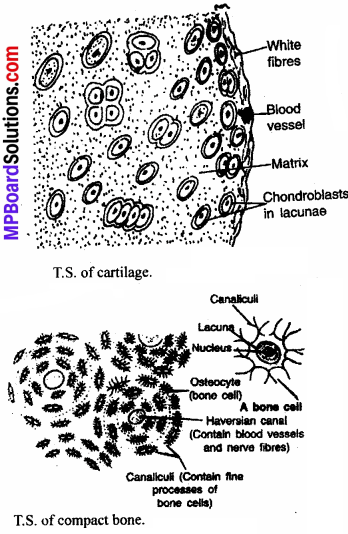
Question 17.
Explain the structure of a fluid connective tissue.
Answer:
Blood is a fluid connective tissue consists of:
- Blood plasma: It is the fluid matrix which contains 85% to 90% water, 7% different types of proteins, 0.9% of salts, about 0.1% glucose and a very small amount of hormones, wastes etc. In the plasma, blood corpuscles (cells) are suspended.
- Blood cells. Three kinds of blood cells are found suspended in the blood plasma.
These are:
(a) Red blood corpuscles (erythrocytes) or RBC
(b) White blood corpuscles (leucocytes) or WBC and
(c) Blood platelets.
(a) Red blood corpuscles (erythrocytes) or RBC:
The red blood corpuscles are biconcave, disc – like cells which are devoid of nucleus. They contain a substance called haemoglobin because of this they appear red in colour. The most important function of the RBC is the transport of oxygen and carbon dioxide.
(b) White blood corpuscles (leucocytes) or WBC: These cells are comparatively larger in size, colourless and irregular in appearance. They are devoid of haemoglobin. They protect our body from diseases by destroying germs.
(c) Blood platelets: These are small, 2 – 4μ in diameter. They are without nucleus. Their main function is to liberate some substances which helps in blood clotting.
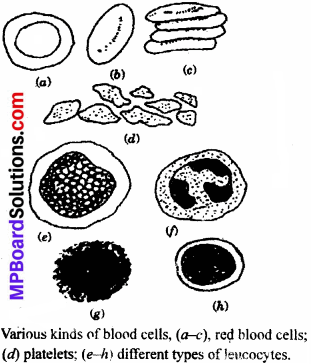
Question 18.
What are areolar tissue and adipose tissue? Where are they located?
Answer:
- Areolar tissue: It is a connective tissue which consists of matrix, several types of cells, collagen and elastin fibres.
- Location: They are found between the skin and muscles, around blood vessels and nerves and in the bone marrow.
- Functions: It fills space inside the organs, support internal organs and helps in repair of the tissues.
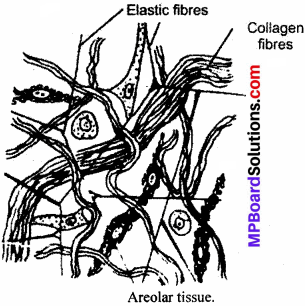
- Adipose tissue: It consists of cells (adipocytes) which are filled with fat globules. These cells remain scattered in a matrix.
- Location: It is found below the skin and between internal organs.
- Function: It stores fats and act as insulator.
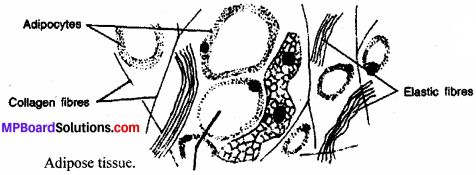
Question 19.
(i) What is a nervous tissue?
(ii) Draw a well labelled diagram of neuron. (label any 4 parts).
Answer:
(i) Nervous Tissue: Nervous tissue is made up of specialised cells called nerve cells or neurons. Each nerve cell is elongated in shape and consists of three parts: cell body, dendrites and axon.The cell body contains a distinct nucleus and has a special kind of granules, called Nissel’s granules in the cytoplasm. From the cell body a single long part called the axon and many branched parts called dendrites arise. In some nerve cells, the axon has a thick white covering called medullary sheath. The terminal end of axon is without sheath and branched. Each nerve cell receives message through the dendrites and sends them to the axon (see Fig. below).
(ii)
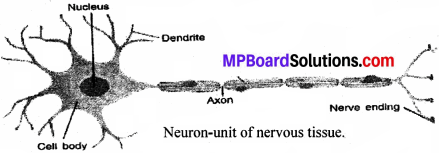
Tissues Higher Order Thinking Skills (HOTS)
Question 1.
Cutting of rose plant is done timely in gardens, but still it regain its length. Give reason.
Answer:
In rose plant, intercalary meristeim is present at the base of leaves or internodes. The cells of these tissues, therefore divide and increase the length of plant.
![]()
Question 2.
Why does water hyacinth floats on water?
Answer:
A type of parenchyma called aerenchyma is present in water hyacinth. This encloses a lot of air and makes the plant lighter than water. Therefore, it floats on water.
Tissues Value Based Question
Question 1.
A patient suffering from paralysis was unable to walk. His family members took the utmost care of him:
- Name two tissues responsible for the movement of body?
- What are the tissues present in brain and spine?
- What value of the family members is seen in the above case?
Answer:
- Two tissues responsible for movement of the body are nervous tissue and muscular tissue.
- The tissues present in brain and spine are nervous tissues.
- His family members showed the value of being kind, caring, dutiful and responsible.